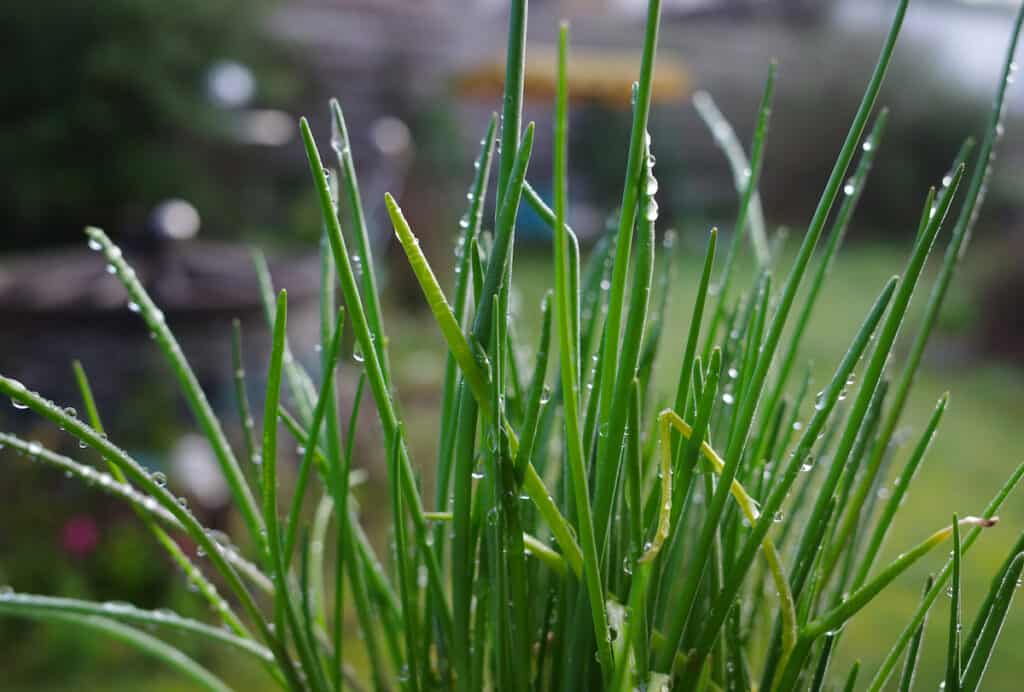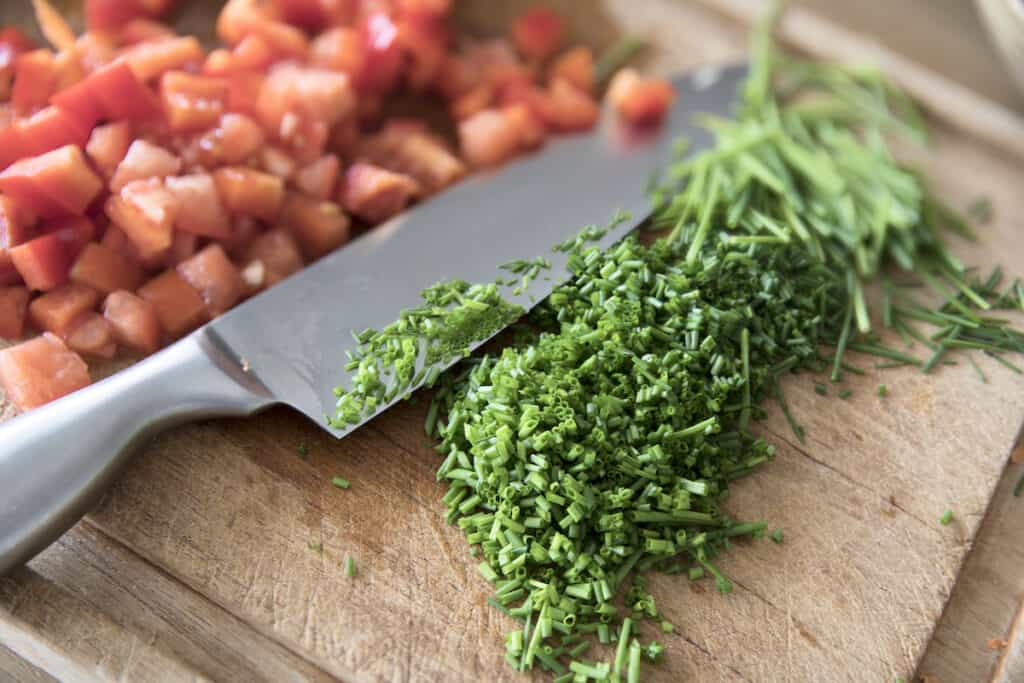Fresh chives add a subtle vegetal flavor to a variety of dishes. They offer a delicate and nuanced flavor similar to both onion and garlic. With just a few snipped chives, you can impart a lightly spicy, somewhat sweet taste to dishes from potatoes to roasted meats and seafood.

Selecting fresh chives
Chives are a perennial herb that belongs to the onion family. This means they are available year-round. Once chives have reached at least 6 inches in height, they can be trimmed with sharp kitchen scissors or gardening shears.
Chives have long, thin, bright green shoots. They are fragrant, with a mild scent likened to onion and garlic.
Whether you plan to grow herbs inside or in an outdoor garden, the plant is easy to grow. Be sure to trim the outer leaves of the chives rather than the inner growth to ensure they continue to produce new shoots. You can also usually find chives at the grocery store all year.
“I love using chives because I can just cut what I need from the garden, wash them and use them in just about any dish. It adds a delicious flavor that you just can’t get with dried chives.”
— Gena, Ginger Casa
When buying chives from the market, choose bunches that are vibrant green in color, soft and fragrant. Be sure there are no black, brown or moldy spots on the shoots and that the leaves are not dried out. Avoid containers with excess moisture. This can lead to mold growth.
The taste of chives
As a member of the onion family, chives are often compared in taste to a cross between an onion and garlic. However, the taste of chives is more delicate and mild. They are quite similar to green onions or scallions.

Cleaning chives
To clean fresh chives, first remove any dry or damaged shoots. Discard any packaging like plastic containers, rubber bands or twist ties. If there are any shoots with black spots, brown spots or flowers, remove and discard these as well.
Next, rinse the chives under cold running water. Remove any pieces of dirt or debris present. Run the chives through a salad spinner to dry them, or pat them dry with a kitchen or paper towel.
FDL’S 75 Best Bites

Our cookbook with 75 tasty recipes will be your go-to kitchen companion for easy dinners with ad-free recipes right at your fingertips. Crafted by experienced chefs and recipe developers, this collection offers a treasure trove of tried-and-true dishes that make mealtime a breeze.
Get the Recipe: FDL’S 75 Best Bites
Storage suggestions
Unlike hardy herbs such as oregano, thyme or rosemary, chives are a soft herb. Soft herbs require extra care when stored to preserve their flavor and texture and prolong the life of the herbs.
A popular option for storing fresh chives is in a glass of water in the fridge. Snip the base of the chives and store them in a glass partially filled with cool, clean water. If your chives are long, try covering them with a sandwich bag. Be sure to change the water when it becomes murky.
Chives can be stored in a damp paper towel in a plastic or reusable silicone bag. The chives can then be stored in the refrigerator.
You can also dry chives by using a dehydrator, air fryer or in a bowl on the counter. Snip the chives into the bowl and let dry completely before storing them in an airtight container.

Chives can also be frozen. Add chopped chives to the compartments of an ice cube tray, cover them with cold water, then freeze. Use frozen chives in soups, sauces and stews.
Culinary uses for fresh chives
Soft herbs like chives should be added at the end of the cooking process. Chives are most commonly added as a garnish after a dish has finished cooking. Because they have a delicate flavor, you can be generous with your chives and try them in a wide variety of applications.
“Sprinkling fresh chives on my scrambled eggs, deviled eggs and omelets is my favorite way to use them. I also love using them in appetizer dips. There is just nothing like the delicate flavor of chives to brighten an otherwise plain dish.”
— Susannah Brinkley Henry, Feast + West
Chives are delicious as a garnish for baked or roasted potatoes, roasted vegetables, seafood dishes, roast chicken, pork, beef or lamb. You can use them to garnish soups, stews and pasta or rice dishes. It’s commonly paired with salty and creamy foods, like sour cream and cheeses.

Fresh chives are used by many cultures where they grow natively. They are used in many North American, European and Asian dishes.
Final thoughts
Chives are a perennial herb used by a variety of cultures. It is easy to grow and prized for its delicate, soft, flavorful shoots.
Chives are typically available at grocery stores throughout the year. Choose bunches with fragrant, vibrant green leaves. Avoid bunches with brown, black or moldy spots, dried-out bunches or bunches with excess moisture in a plastic container.
You can store chives in water or in a damp paper towel. Be sure to clean them well before storage. They can also be dried or frozen to use at a later time.
Chives should be added as a garnish. They will lose their flavor if added at the beginning of your cooking time. Fresh chives are used to top everything from baked potatoes to roasted meats to dips. Add chives to your garden or select a bunch at your local market to enjoy fresh, subtle allium flavor in all your favorite dishes.
Gen La Rocca is a professional chef, writer and editor living in Southern California. She is the owner and recipe creator behind Two Cloves Kitchen, a food site featuring contemporary, California-inspired recipes. She has edited over 20 novels, short stories and essays for publication.